Godzilla & Rodan & Mothra & Alice: Destroy All Monsters on Blu-ray!
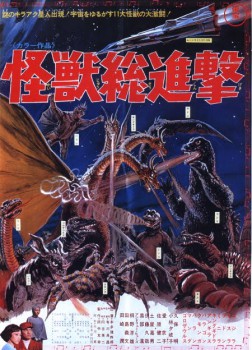 Last month, the second Godzilla film to reach Blu-ray in North America made its thundering, skyline-flattening debut, courtesy of Media Blasters: the 1968 science-fiction monster mash Destroy All Monsters (Japanese title: Kaiju Soshingeki, “Charge of the Monsters” or “Monster Invasion”). The only Godzilla movie to beat it onto Blu-ray is the 1954 original, which will get a re-release as part of the Criterion Collection in January 2012. (The Criterion Collection! Godzilla has gained a well-deserved highbrow victory and sits on the same shelf with Kubrick and Bergman!) Later this month will see the third Godzilla Blu-ray release, 1973’s Godzilla vs. Megalon. This is arguably the worst movie of the long series, but I welcome it onto Hi-Def nonetheless: three cheers for glittering mediocrity!
Last month, the second Godzilla film to reach Blu-ray in North America made its thundering, skyline-flattening debut, courtesy of Media Blasters: the 1968 science-fiction monster mash Destroy All Monsters (Japanese title: Kaiju Soshingeki, “Charge of the Monsters” or “Monster Invasion”). The only Godzilla movie to beat it onto Blu-ray is the 1954 original, which will get a re-release as part of the Criterion Collection in January 2012. (The Criterion Collection! Godzilla has gained a well-deserved highbrow victory and sits on the same shelf with Kubrick and Bergman!) Later this month will see the third Godzilla Blu-ray release, 1973’s Godzilla vs. Megalon. This is arguably the worst movie of the long series, but I welcome it onto Hi-Def nonetheless: three cheers for glittering mediocrity!
But Destroy All Monsters is anything but mediocre: like Universal’s House of Frankenstein over twenty years before, it pulls together all the science-fiction candycorn goodness available to give audiences a mad monster party for the ages. The plot is simplistic, the characters even more so, but the movie pops with color and spectacle of a bygone age of entertainment without irony. It isn’t the best of the Godzilla series, but until 2004’s Godzilla: Final Wars, no monster movie could boast a larger monster cast. Eleven of Toho Studio’s stable of big beasts crowd into its hundred minutes, and the result is a giddy confection no ten-year-old or ten-year-old at heart can resist. If geekdom has a defining film, here it is.
Destroy All Monsters was one of the first of Japan’s giant monster films to reach DVD in North America. At the time it seemed like a miracle to have a Godzilla film available in a letterboxed edition. However, the 1999 disc from ADV Films is the textbook example of a barebones release: the only language option is the inferior of the two English dubs (I’ll explain the dubbing situation later), the picture isn’t enhanced for widescreen TVs, and the disc doesn’t even have a menu. As better quality Godzilla DVDs came out in the 2000s, Destroy All Monsters became a black hole on collectors’ movie shelves. ADV re-released the movie to DVD in 2004 packaged with a soundtrack album as part of Godzilla’s Fiftieth Anniversary, but the movie disc is exactly the same.
The Media Blasters/Tokyo Shock Blu-ray fixes all these problems: not only is the film in glorious Toho Scope 1080p, but the disc contains both English dubs, the original Japanese mono soundtrack, a 5.1 lossless re-mix, and commentary from two Japanese fantasy film scholars, Steve Ryfle and Ed Godziszewski, who have done informed and lively commentaries for previous Godzilla DVD releases.
By 1968, the Japanese film industry had entered a decline from its halcyon days. Theater attendance was dropping because of the influence of television. TV especially injured special effects (tokusatsu) movies and their most profitable subgenre, the giant monster (daikaiju) movie. A wave of superhero shows, such as Ultraman, competed for young viewers’ attention. Toho’s front office decided it was the right time to close up the Godzilla series, and they lavished a budget of USD $550,000 on a big blow-out bringing together almost a dozen monsters — plus alien invaders and super-tech!
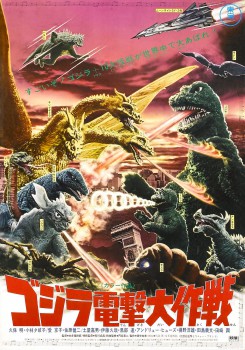 Destroy All Monsters did not conclude the Godzilla series as Toho intended, but it was the final great glory of the classic series before the low-budgets of the 1970s. For one last time, the four “Godzilla-fathers” who brought the monster to screen in 1954 worked together: director Ishiro Honda, visual effects supervisor Eiji Tsubaraya, producer Tomoyuki Tanaka, and composer Akira Ifukube.
Destroy All Monsters did not conclude the Godzilla series as Toho intended, but it was the final great glory of the classic series before the low-budgets of the 1970s. For one last time, the four “Godzilla-fathers” who brought the monster to screen in 1954 worked together: director Ishiro Honda, visual effects supervisor Eiji Tsubaraya, producer Tomoyuki Tanaka, and composer Akira Ifukube.
Screenwriter Takeshi Kimura was one of the two writers who tackled most tokusatsu writing duties at Toho. The other author, Shinichi Sekizawa, took great joy in penning science-fiction and fantasy scripts, while Kimura had a more dour approach and tended toward pessimistic, bleak pieces, such as the superb 1963 horror movie Matango (released in the U.S. under the dopey title Attack of the Mushroom People). Destroy All Monsters is Kimura’s biggest contribution to the Godzilla series, and it departs from his darker style.
The screenplay for Destroy All Monsters is openly utopian, more in keeping with the humanist themes so dear to director Ishiro Honda, who shares script credit with Kimura. The story takes place in the futuristic late twentieth century, a peaceful time of world cooperation, jackets without lapels, and video monitor phones. All the globe’s monsters are kept in “Monsterland,” a part of Ogasawara Island and its research center. The film opens with a tour of the island; the narrator introduces most of the big name kaiju and shows how security keeps them restrained on the island without harming them.
But the world’s peace suddenly faces a dangerous threat: the invasion of the Kilaaks! These living metal aliens follow the playbook from 1965’s Invasion of Astro-Monster (released in the U.S. as Monster Zero) and seize control of Earth’s monsters, turning them loose on the great cities of the world. The nations of Earth band together in large control rooms with enormous monitors and many blinking lights to respond in Astro-Monster fashion: they regain control of the monsters and turn them on the Kilaaks and their space-beast, King Ghidorah, culminating in a massive monster showdown.
That’s the entire plot. It holds together a group of big money scenes involving city destruction, military assaults on looming rubber beasts, and spaceship adventure, with a few character moments involving the Kilaaks controlling humans tossed in so director Ishiro Honda has more to work with. Like another of Honda’s classic science-fiction epics, 1959’s Battle in Outer Space, there isn’t much characterization to Destroy All Monsters. This puts it below the quality of many of Honda’s other tokusatsu movies, but its massive scope and “wow” factor keep it entertaining for the imaginative child in all of us.
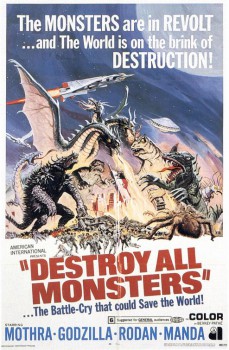 Although the characters don’t have much depth on paper, they benefit from the ensemble of actors that director Honda worked with numerous times: Jun Tazaki, Akira Kubo, Yoshi Tajima, Ikia Sawamura, and Yoshio Tsuchiya. They all nail the stock parts they played in previous films, such as Tazaki as a stalwart top government official so similar to the one he played in Invasion of Astro-Monster that it might as well be the same character. Yoshio Tsuchiya gets the best part as a doctor from Monsterland Control Center who falls under Kilaak hypnotic command. Tsuchiya is a famously eccentric performer who relished playing aliens (Invasion of Astro-Monster, The Mysterians) or men under alien control (Battle in Outer Space), and usually got the juiciest parts in science-fiction films. Tsuchiya is a magnetic presence on screen even when he isn’t speaking, and his best scene in Destroy All Monsters unfurls without a word of dialogue. Unfortunately, Tsuchiya’s Dr. Otani doesn’t make it through the halfway point of the film, and no character can replace him in the personality department.
Although the characters don’t have much depth on paper, they benefit from the ensemble of actors that director Honda worked with numerous times: Jun Tazaki, Akira Kubo, Yoshi Tajima, Ikia Sawamura, and Yoshio Tsuchiya. They all nail the stock parts they played in previous films, such as Tazaki as a stalwart top government official so similar to the one he played in Invasion of Astro-Monster that it might as well be the same character. Yoshio Tsuchiya gets the best part as a doctor from Monsterland Control Center who falls under Kilaak hypnotic command. Tsuchiya is a famously eccentric performer who relished playing aliens (Invasion of Astro-Monster, The Mysterians) or men under alien control (Battle in Outer Space), and usually got the juiciest parts in science-fiction films. Tsuchiya is a magnetic presence on screen even when he isn’t speaking, and his best scene in Destroy All Monsters unfurls without a word of dialogue. Unfortunately, Tsuchiya’s Dr. Otani doesn’t make it through the halfway point of the film, and no character can replace him in the personality department.
Akira Kubo, who played a nerdy scientist in Invasion of Astro-Monster and an enthusiastic reporter in Son of Godzilla, gets the heroic leading man part: Katsuo Yamabe, captain of the Moonlight SY-3, a groovy spaceship that powers most of the human action. Kubo is stern and commanding, but Katsuo doesn’t have anything like a character arc or any conflict aside from “Let’s beat these Kilaak bastards.”
Even though Destroy All Monsters doesn’t offer its characters much drama, it provides them plenty of action scenes, creative futuristic locations, and snappy gizmos and vehicles to keep audiences flying along until the next giant beast pops to smash stuff. Monster battles run up the budget fast, so laser-gunfights and alien base infiltrations fill in. The only place where the movie drags is when the crew of SY-3 tries to shut down the Kilaaks’ monster-control machine in their lunar underground headquarters. Katsuo blasts a laser into the device’s base while frenetic music plays on the soundtrack, and it seems to go on forever. Thankfully, once this is done, the film leaps right into the monster-crammed finale.
Of course, we showed up to see the rubber monster beating the hell out of each other and miniature tanks, plane, and buildings. The film structures their action scenes toward two epic set-pieces: First, the mid-movie mass-destruction of Tokyo, with Godzilla, Rodan, Manda, and Mothra laying waste to the city while the UN forces hammer them with the most spectacular assault of missiles seen in the classic Toho films. Second, a climatic clash between the ten monsters under human control against the alien’s champion, King Ghidorah. (Two of the monsters do almost nothing in the big fight, however, as I’ll talk about below.) Before and between these spectacles, the monsters pop up to harass the heroes and destroy monuments across the world.
Since the monsters got us to pay our nickel for this train ride, each one deserves individual attention. I’ll use the order posted on the back of the Blu-ray, which lines up the stars with their circular trademark badges:
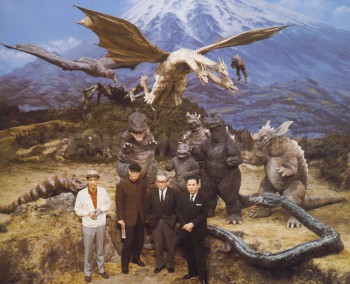 Godzilla
Godzilla
Since Destroy All Monsters belongs to the Godzilla series, Toho’s tallest star gets the best treatment. The effects department built a new Godzilla suit for the film, and it improves over the awkward frog-like outfit from the previous film, Son of Godzilla. This new suit would have the longest run of any Godzilla costume, appearing in the next three films. By its final appearance, Godzilla vs. Gigan, the suit was flaking apart in front of the camera, but it looks superb here. Godzilla still has a shorter snout and a more friendly look than the earlier outfits, but it’s a personable design that lets suit performer Haruo Nakijima give a genuine performance.
Godzilla has plenty on his plate, and appears in most scenes involving the monsters. He attacks New York and blows up the UN building — the only time in the Japanese Godzilla series that the monster attacked the U.S. The New York miniature is a bit sketchy, but it’s Godzilla in frackin’ New York, so I’m not going to complain. Godzilla leads attack in the finale, which completes the character’s transformation from force of destruction to superhero. Godzilla would remain in this role through the 1970s until the end of the classic series.
Mothra
After Godzilla, this giant moth/Island god is the most popular Toho monster in Japan. Unfortunately, Mothra remains in its less interesting larval stage for the whole movie. The winged puppet (last spotted in Ebirah, the Horror of the Deep in 1966) was in poor condition, apparently. Mothra still keeps busy, taking part in the Tokyo assault, derailing a train near Beijing, and using its silk webbing to restrain King Ghidorah.
King Ghidorah
Godzilla’s most famous adversary, the awesome three-headed golden space dragon, makes its third appearance as the principle kaiju villain. King Ghidorah is the only monster in the film not kept on Ogasawara Island; the Kilaaks use it as a back-up plan when the crew of the Moonlight SY-3 destroy their control over the Earth. Why the aliens thought King Ghidorah could beat ten earth monsters when it already received sound thrashings from far fewer in its last two movies remains a bit of a mystery. Overconfidence is also the downfall of Toho alien invaders, it seems. The movie re-uses the costume from King Ghidorah’s earlier appearances, but with stiffer wing fabric.
Rodan
This Pteranodon-inspired flying monster debuted in its own film in 1956, but has never looked as magnificent since that first outing. (I love that movie.) The Rodan suit used for Ghidorah, The Three-Head Monster (1964) and Invasion of Astro-Monster gets reused with some modifications, but the smaller flying model looks far superior. Rodan’s best moments have it demolishing Moscow from the air, chasing the SY-3, and taking to the skies in the attack on Tokyo. On the ground in the final battle, the winged monster looks awkward.
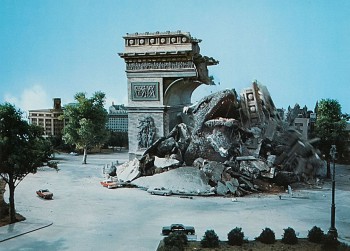 Gorosaurus
Gorosaurus
For an obscure monster that has only two appearances to its credits, Gorosaurus gets featured guest star treatment in Destroy All Monsters. The Allosaur-like dinosaur debuted in King Kong Escapes the previous year, so the suit was almost new, which explains why the VFX crew makes so much use of it. Gorosaurus wrecks Paris in a part originally meant for Baragon, and gets into the heart of the fight with King Ghidorah, where it floors the evil dragon with a “kangaroo kick” maneuver guaranteed to bring cheers from audiences.
Anguirus
This kaiju is the biggest callback of the cast. The quadruped with the spiky carapace (often called “Angilas” in U.S. dubbing and promotional material) is the first monster Godzilla ever battled, back in Godzilla Raids Again (1955). It appears here in a new costume that is the best of the suits constructed specifically for the movie. Anguirus prominently joins Godzilla to defend a Kilaak base from a UN force attack. In the finale, Anguirus shows incredible/foolhardy bravery and charges King Ghidorah on its own — and then gets viciously trounced in one of the best monster moments in the film. Anguirus became a fan-favorite because of its feistiness against overwhelming odds, and would appear in two more of the 1970s Godzilla films. Having a new suit helps your job prospects, even if you’re a monster.
Kumonga
The giant spider, called “Spiga” in the AIP dub, that appeared the year before in Son of Godzilla joins with Mothra to web-up King Ghidorah in the big fight, but that’s all. The puppet from the earlier film was in excellent shape and is used as-is.
Manda
A new head was put on the body of the serpentine water dragon from the super-submarine movie Atragon (1963). The new head lacks the horns and frills that gave Manda its “Chinese Dragon” appearance in Atragon, but the refurbished kaiju is one of the surprises of Destroy All Monsters. Manda takes part in the four-way demolition of Tokyo, during which its wraps its body around an elevated train track and crushes it in its coils, one of the film’s most memorable images. A filmed but deleted scene had Manda tangle with Godzilla during the Tokyo mayhem. Manda only appears as a miniature puppet during the big final battle, however.
Minira
A.k.a. Minya, Minilla, Baby Godzilla, the Infant Michelin Man. It seems that Godzilla’s species ages very slowly, since his “son” is still the same size it was in Son of Godzilla, which takes place thirty years earlier in this timeline. Minira mostly provides reaction shots during the final fight, but gets to deliver the insulting coup de grâce against King Ghidorah with a radioactive smoke ring.
Baragon
This puppy-dog-eared tunneling reptile faced off against a giant Frankenstein Monster in 1966’s Frankenstein vs. Baragon (original U.S. title: Frankenstein Conquers the World). Although the Baragon suit was a recent fabrication, it was in rotten shape because it hit the guest-circuit hard in the TV shows Ultra Q and Ultraman, where the VFX crew modified it to appear as multiple different monsters. Baragon therefore only pops up in the final battle as a puppet on the fringe of the action (a single shot) and then in full costume in the coda (also a single shot). He was supposed to have a bigger role as the destroyer of Paris, but Gorosaurus was substituted — nonsensically, since Gorosaurus doesn’t burrow. The newsman’s dialogue, in English and in Japanese, still identifies Baragon as the Parisian attacker.
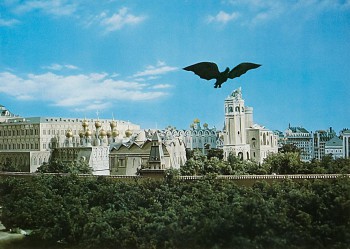 Varan
Varan
The title monster of the dull Varan the Unbelievable (1958), my least favorite of Ishiro Honda’s many tokusatsu films, appears only as a flying puppet in two short moments, one at the start of the big battle, and the other in the Monsterland wrap-up. The monster has never appeared in any movie since. He couldn’t land a spot in Godzilla: Final Wars, and even the lame Roland Emmerich version of Godzilla, renamed Zilla, is in that!
Special effects wizard Eiji Tsubaraya died less than two years after the release of Destroy All Monsters, but he was already withdrawing from his work with the Toho Special Effects Department that he headed to concentrate on television work. (He produced Ultraman, and the company he founded continues to make hit television special effects shows in Japan to this day.) On Destroy All Monsters, Eiji Tusbaraya served as a “Visual Effects Supervisor,” and left the hands-on work to his assistant Teisho Arikawa. Arikawa executes some spectacular scenes on a tight budget, although nothing matches the beauty of the sequences in some of Tsubaraya’s previous classics like Invasion of Astro Monster, Gorath, Mothra vs. Godzilla, or Battle in Outer Space. Some of the optical work is sloppy, wrinkles appear on some of the sky backdrops, and the models of foreign cities look much weaker than the extensive design of Japan for the big smash-up.
But the VFX for the action with the Moonlight SY-3 on the lunar surface and especially for the final kaiju smackdown at the foot of Mt. Fuji provide amazing fun. The effects aren’t “realistic,” but nobody goes into Japanese fantasy looking for realism; that would be boring. Even with these expectations, some of what occurs in the big monster battle is awe-inspiring. The monsters fight across a sprawling miniature on Toho’s enormous Stage 11 before a cyclorama painting of Mt. Fuji that looks photo-realistic in some shots. The amount of work that went into choreographing the action with multiple suit performers and wired props controlled from the rafters makes this one of the most impressive monster battles ever put on film. To push it over the edge, a TV announcer provides an enthusiatic play-by-play to give the scene the feeling of the ultimate boxing match. Which it sort of is.
Composer Akira Ifukube re-uses his themes from earlier Godzilla films, creating something of a “Greatest Hits” for a movie that certainly calls for it. The Godzilla “horror theme,” the soaring trumpet-powered Rodan motif, and the booming bass for King Ghidorah appear to drive the monster action with appropriate furioso. A new march plays over the credits and for military attacks, and the Kilaaks receive appropriately eerie tones that will remind many viewers of the scores for Star Trek: The Original Series. However, the mad-piano that plays over the endless scene of shutting down the Kilaak control device isn’t something you’ll want to hear often.
The two previous Godzilla movies, Ebriah, the Horror of the Deep (first released in the U.S. as Godzilla versus the Sea Monster) and Son of Godzilla, skipped theatrical release in the U.S. and went direct to television. Fortunately, American International Pictures snatched up Destroy All Monsters and did a quick turnaround to get it onto American screens less than a year after its Japanese release. AIP created a superb promotional campaign (“Destroy All Monsters: The Battle-Cry That Could Save the World!”) and did brisk business with the movie. It then played in syndication on U.S. television until the early 1980s, when AIP’s rights evaporated and the movie vanished into the ether.
When Destroy All Monsters reappeared in 1996 on the Sci-Fi Channel and then on VHS and DVD, it contained a dub unfamiliar to American viewers who grew up on the original television broadcasts. This English language track was not “new,” however; Toho commissioned it in 1968 to send sell the film to English language markets. AIP did their own dub with Titra Sound in New York, which explains why there are two English audio options on the Blu-ray.
Dueling English dubs are nothing unusual in Japanese fantasy movies. Toho prepared their “International dubs” from Hong Kong, usually with a company called Frontier Enterprises, and offered them to all English territory. U.S. distributors often found these dubs inferior and created their own. The Media Blasters Blu-ray is the first home video release of a Toho monster film with both the international and domestic dubs included. Listeners can hear exactly why AIP wanted to scrap what Toho handed them. The international dub on audio track 1 has superior sound quality, but dull performances from voice actors who were probably amateurs taken from local businesses. The AIP dub on audio track 2 suffers from age deterioration, but the script and actors are vastly superior, with nostalgic voices familiar to anyone who watched episodes of Speed Racer and Ultraman as a child. The syncing with the lip movements is also improved; Titra Sound always produced excellent dubs. If you watch Destroy All Monsters with children who don’t want to read subtitles, go with the second track and try to ignore the occasional pops and distortions.
The 5.1 Japanese DTS-HD re-mix spreads the sound field without taking a revisionist approach, keeping the dialogue and sound effects on the front three speakers and expanding for Ifukube’s music. The original Japanese 2.0 mono, however, is the most vibrant of the audio options, and viewers should stick to this and crank it up when the missiles start flying.
The picture quality of the Blu-ray won’t dazzle anyone who has seen The Lord of the Rings box set, but considering the source material it more than satisfies. The image is a touch soft, but there is almost no damage or noticeable DNR distracting from the viewing experience. Destroy All Monsters has never looked better, and the Blu-ray promises more fine releases of kaiju films in the future.
My vote for the Godzilla film that most urgently needs the Blu-ray treatment: King Kong vs. Godzilla. The original Japanese cut has never gotten an official U.S. release, and the Universal-International hack-job version and the Japanese one can easily sit together on one disc. I’m starting a hopeless petition to see this happen.
(If anyone gets the movie-riff in my title, I’ll be very pleased.)
Ryan Harvey is a veteran blogger for Black Gate and an award-winning science-fiction and fantasy author. He received the Writers of the Future Award in 2011 for his short story “An Acolyte of Black Spires,” and has two stories forthcoming in Black Gate, as well as a currently available e-book in the same setting. He also knows Godzilla personally. You can keep up with him at his website, www.RyanHarveyWriter.com, and follow him on Twitter.
Great! I was beginning to think we’d never get a decent home version of this movie.
Much as I enjoy some of the later Godzilla movies, it’s the classic era that is best to me, including all the other monster/sci-fi movies Toho did. It feels to me almost like the film equivalent of Silver Age Marvel comics, with all the wild monsters, aliens, spy action, and crazy weaponry.
Ahh! Until STAR WARS arrived in 1977, DESTROY ALL MONSTERS was my favorite movie, hands down. Damn, I loved it with a fierce passion, as only a 12-year old can.
I haven’t seen it in years. Last time was half a reel at a SF convention.
I really don’t remember the movie very well any more, just fractured images of the climatic battle, and some action in a cave near the beginning.
Thanks for the trip down memory lane, Ryan. I have no hope my children would ever enjoy this movie. But maybe I’ll get a copy and watch it alone some night, and relive the year 1975, when giant monsters were the coolest thing ever.
What am I saying. Giant monsters ARE the coolest thing ever. Since when did that change?
[…] core of the film, I’ll break the rest of the movie down hero-by-hero, similar to what I did in my Destroy All Monsters […]
[…] comic book style. Godzilla: Final Wars in 2004 would throw even more monsters into the mix, but Destroy All Monsters is the movie people remember, and is forever identified with the idea of fan-pleasing crossover […]
[…] Studios planned to conclude the Godzilla series with 1968’s epic Destroy All Monsters. But their resolution did not hold for long. Although the studio system would not collapse for […]
[…] of Godzilla vs. Biollante, displaying greater imagination and energy than anything seen since Destroy All Monsters in 1968. The new Godzilla suit design, which would remain consistent for the remainder of the […]